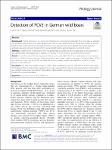Detection of PCV3 in German wild boars
Prinz, Carolin
Stillfried, Milena
Neubert, Lena Katharina
Denner, Joachim
Background
Porcine circovirus 3 is a newly described circovirus circulating worldwide. PCV3 may play an etiologic role in different pig diseases. Two different genotypes of PCV3 were described, PCV3a and PCV3b. In order to analyse whether PCV3 is also present in wild boars, animals living in and near Berlin were studied. The animals had been analysed previously and were found to form two genetically distinct and geographically coherent clusters.
Methods
To detect PCV3 in wild boars, a PCR was performed, to analyse the virus in detail, parts of the sequence of the capsid protein were sequenced. In addition, a screening for PCV1 and PCV2 was performed using PCR.
Results
For the first time, PCV3 was detected in German wild boars, with 50% of the animals infected in one genetic cluster, and 23% in the second cluster. In both populations which were divided in the years of division of Berlin, PCV3b was detected, in one case also PCV3a was detected. In some animals, co-infections with PCV1 and PCV2 or triple infections were detected.
Conclusion
The data show a high prevalence of PCV3 and co-infections with PCV1 and PCV2 in German wild boars. The finding of PCV3 in both clusters suggests that the virus was introduced into the animal populations before Berlin was divided. Furthermore, the methods used will be indispensable for screening for circoviruses in pigs genetically modified for xenotransplantation.
Dateien zu dieser Publikation

